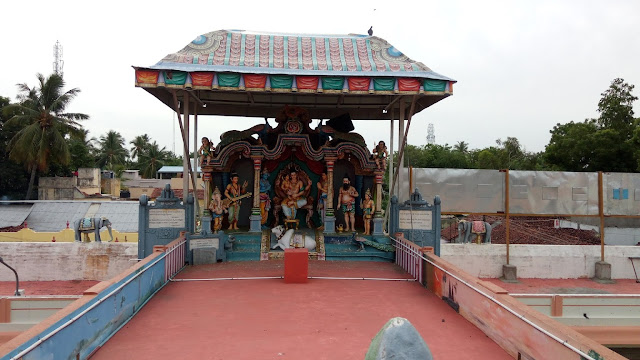Swaminatha Swamy Temple,
Swamimalai – The Temple
This Temple is considered as one of the six abodes (Padai Veedu) of Lord Murugan. Swamimalai is the 4th Padaiveedu (army camp) of Lord Muruga. The temple is built on an artificial hill (called as Kattu Malai in Tamil). The temple has three gopuram (gateway towers) and three precincts. Out of the three precincts, one is located in the basement, the second at midway to the top of the hillock and the third on the hillock, around the sanctum of the Swaminatha Swamy shrine. The southern entrance is the main entrance to the temple and the main temple tower (Raja gopuram) is of 5 tiers, is located above this entrance.
The other entrances do not have any towers above them. There are sixty steps and each one is named after the sixty Tamil years. These are considered at par with the importance of 18 steps in Sabarimalai. The deities of the Tamil years are praying to Lord Muruga in the form of steps. Hence, the Padi Puja (puja for the steps) is conducted on Tamil and English New Year days with coconuts, fruits and singing hymns. The first thirty steps lead to the second precinct of the temple.
There is a shrine of Vallaba Ganapathy at the eastern entrance outside the first precinct. Shrines of Sundareswarar and Meenakshi is situated downhill in the first precinct. Shrines and idols of Somaskanda, Viswanathar, Visalakshi, Dakshinamurthy, Durga, Chandikeswarar, Navagrahas and the festival image of Swaminatha Swamy can be seen in the first precinct. The second precinct is the largest precinct in the temple. It houses a marriage hall and the chariot of the temple. There is a beautiful sculpture depicting the teachings of Pranava Mantra by Lord Muruga to Lord Shiva.
Shrines and idols of Karthaveeryarjuna, Idumban and Subramanya Swamy can be seen after crossing the second precinct. The Netra Vinayakar shrine is located adjacent to the flagstaff. Presiding Deity is called as Swaminatha Swamy / Balamurugan and is facing east. He is housed in the sanctum. The Sanctum is located atop a 60 ft (18 m) hillock. He is about six feet tall with tuft in his head, sacred thread on the chest and a staff in the right hand and the left on the lap. He is in standing posture without any of his consorts.
He graces in meditative posture as a Guru. He graces with the Vajra Vel representing three divine powers – Itcha Shakti, Gnana Shakti and Kriya Shakti. If one closely observes the sanctum sanctorum, the peeta (stage) on which the Lord stands looks like the Shivalinga Avudaiyar and the Lord as Shivalinga itself. This represents the philosophy that Lord Shiva and Lord Muruga are but one and not different from each other. There are golden armours, golden crowns and a diamond lance for Swaminathaswamy.
The original animal mount of Murugan is believed to have been an elephant, compared to the peacock which is considered to be the most common mount. The white elephant is considered a powerful, terror striking animal. The iconography is maintained only in two places, namely, this temple and Thiruthani Murugan Temple. Unlike other Murugan temples, where peacock is sported axial to the image of the presiding deity, an elephant is seen in front of Murugan in the temple.
Shrines and idols of Sabapathy with his consort Devasena, Senapathy with his consort Valli, Lord Shanmuga with Valli and Devasena, Nataraja, Mahalakshmi, Veerabahu, Surya, Chandra, Idumban, Dhandayudhapani and Saint Arunagirinathar can be seen in the third precinct. There are five Theerthams associated with this Temple namely Vajra Theertham, Kumara Theertham, Saravana Theertham, Netra Pushkarini (well) and Kumaratturai (Kaveri).
The Sthala Vriksham is the Amla tree (Nelli Maram). The temple has an imposing golden chariot made of seven kilos of gold, 85 kilos of silver and other metals like copper, beautifully illuminated with electric bulbs. Devotees on payment of Rs. 1001 can take the deity in a procession in the golden chariot around the outer corridor. Devotees are offered a shawl, ever silver pot and a small box with the Lord’s Prasadam.














